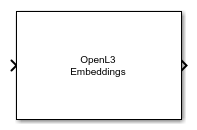OpenL3 Embeddings
Libraries:
Audio Toolbox /
Deep Learning
Description
The OpenL3 Embeddings block uses OpenL3 to extract feature embeddings from audio signals. The OpenL3 Embeddings block combines necessary audio preprocessing and OpenL3 network inference and returns feature embeddings that are a compact representation of audio data. This block requires Deep Learning Toolbox™.
Ports
Input
Output
Parameters
Block Characteristics
Data Types |
|
Direct Feedthrough |
|
Multidimensional Signals |
|
Variable-Size Signals |
|
Zero-Crossing Detection |
|
References
[1] Cramer, Jason, et al. "Look, Listen, and Learn More: Design Choices for Deep Audio Embeddings." In ICASSP 2019 IEEE International Conference on Acoustics, Speech and Signal Processing (ICASSP), IEEE, 2019, pp. 3852-56. DOI.org (Crossref), doi:/10.1109/ICASSP.2019.8682475.
Extended Capabilities
Version History
Introduced in R2022b
